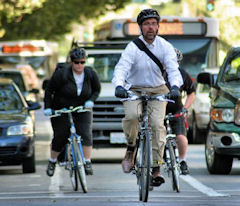 I was driving through one of Henrico County’s most heavily traveled intersections at Parham Road and Patterson Avenue a few days ago when I encountered a remarkable sight: two bicyclists waiting at the stoplight. They weren’t riding together. One was traveling north on Parham and the other heading east on Patterson.
I was driving through one of Henrico County’s most heavily traveled intersections at Parham Road and Patterson Avenue a few days ago when I encountered a remarkable sight: two bicyclists waiting at the stoplight. They weren’t riding together. One was traveling north on Parham and the other heading east on Patterson.
That location is the last spot I’d expect to find anyone riding a bicycle — the suburban roads are totally engineered for the movement of automobiles. But there they were. That’s when it dawned on me: utility cycling isn’t just for downtown Richmond. It’s spreading everywhere.
No questions, change is afoot, or perhaps I should say, apedal. The U.S Census’s American Community Survey has just released data showing that bicycle commuting in the United States increased 9 percent last year, bringing it to an all-time high.
Cycling still remains a tiny transportation-mode niche, accounting for only six-tenths of one percent of the commuting public. But it looms increasingly important in transportation policy. Those 865,000 cyclists are not driving cars, taking up parking spaces and generating pollution.
Moreover, as the D.C. Streets Blog notes, “the growth in bicycling isn’t taking place in a vacuum.” Large cities like New York, Chicago and Washington, D.C., are competing to add the most bike lanes. Even Indianapolis and Memphis are expanding bicycle infrastructure. “Any wagers on how much bike commuting will increase in next year’s Census?”
Meanwhile, the bicycle industry is continually innovating, offering cool new designs and hybrid products like electric bicycles, which makes cycling attractive to new categories of riders.
The bad news is that walking to work is shrinking as a share of commutes, surely a disappointment to those (like me) who hoped that the resurgence of downtown living and building of more walkable, mixed-use communities would lessen dependence upon the automobile. It will take decades to entice a majority of Americans out of their cars — indeed, given continued automotive innovations that make driving cars more attractive, that goal may never be achieved.
— JAB


